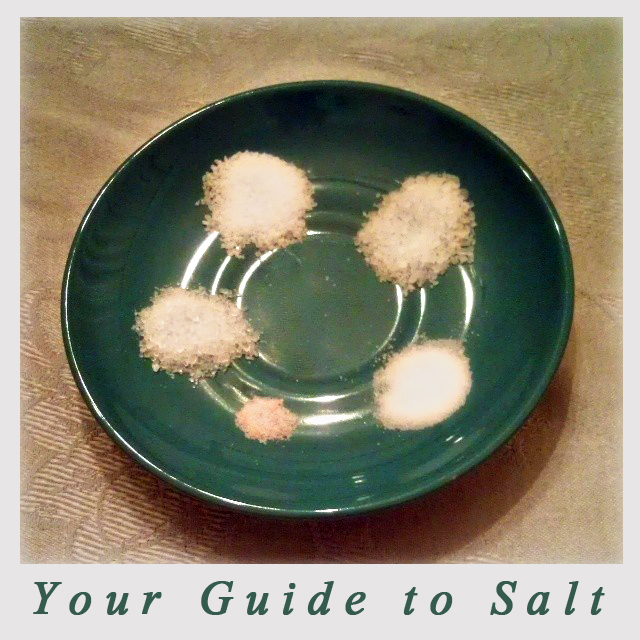Quick . . . list everything that comes to mind when you think about salt. My thoughts immediately wander to potato chips, high blood pressure, ocean, water retention, and vinegar. I’m sure your salty concepts are not too dissimilar to mine. This just goes to show you that we have so many preconceived notions about salt, some of them good and some not so much. Actually, salt is a lot more complex than a passing reference in our favorite recipe that requires us to add a pinch or a dash here and there. Not only does it enhance flavors in our favorite dishes, but it’s essential to our health as well. In order to enjoy the many benefits of salt, we must first learn about some of the different varieties, their properties, and how best to incorporate them into our routine. Not all salts are equal and some are definitely better than others, but they all have a value. I’m learning more and more about the importance of salt, and now my pantry is saltier than a snazzy bottle of those sea salt texturizing sprays that we adore! Here is your ultimate guide to salt varieties and their uses.
Table Salt: The controversial condiment. Some people love it, some people hate it. This salt is mined from underground salt deposits and trace minerals are removed during the processing. Anti-caking agents are then added to prevent the clumping of the granules. The final product is a processed salt composed of sodium chloride and sometimes infused with iodine to assist with healthy thyroid functioning. We are all about keeping our thyroids healthy and all, but sodium chloride alone should be limited in your diet if you are susceptible to high blood pressure. See what I mean? Love it or hate it.
Best Table Salt Tip: In my opinion, skip the table salt and enjoy iodine-rich sea vegetables in your favorite dishes instead!
Sea Salt: Probably the chicest salt of them all – it’s from the ocean. Hello, glamorous! What else would you sprinkle on your black truffle-infused popcorn? Sea salt, of course! Food accessorizing aside, sea salt does not undergo processing after it is harvested through evaporation, and retains its natural form and color–off-white or often gray. What we have is an unrefined salt with essential minerals and traces of elements like sodium, chloride, potassium, calcium, sulfur, zinc, iron, manganese, copper, silicon, and magnesium. These elements play a crucial role in your electrolyte balance and energy production, among many other functions. Sea salt can also help alkalize your body. You might find that a pinch of sea salt in water after your workout is totally replenishing.
Best Sea Salt Tip: Sprinkle it on chocolate chip cookies fresh out of the oven.
Kosher Salt: A coarse salt with a light taste and a flaky texture. Traditionally, kosher salt does not contain additives and the granules are much larger than those of table salt. Chefs love kosher salt because the large crystals make it easier to grab pinches out of salt cellars when adding this salt to dishes. Kosher salt is great for cooking and baking because the large flakes add a bit of a crunch.
Best Kosher Salt Tip: Toss with a simple pasta dish!
Epsom Salt: Okay. Technically not a salt, but it looks like salt. Epsom salt is a mineral compound made of magnesium and sulfate, and named after a natural mineral spring in England. Today, this mineral salt is commercially made and has amazing health benefits. When added to a bath, this duo helps with detoxification, muscle aches, absorption of nutrients, and migraine relief. Epsom salt is awesome!
Best Epsom Salt Tip: Add 1 cup of Epsom salt and a few drops of your favorite essential oil to a relaxing bath and wait for your stress to melt away.
Pink Himalayan Salt: This salt is harvested from ancient sea bed deposits in the Himalayan region and is thought to be the purest and most beneficial salt of all. The color of the granules vary from white, to red, to pink because of traces of iron oxide. Pink Himalayan salt also contains over 80 different traces minerals and elements that are beneficial to your health like, calcium, potassium, and selenium. Not just to eat, larger slabs of this salt are fashioned into crystal rock lamps that are used for air purification because of its mineral composition.
Best Pink Himalayan Salt Tip: Liven up your avocado toast with a dash of these tasty pink crystals!
Fleur-de-sel: One of the most distinguished salts, fleur-de-sel is a sea salt hand-collected from the top layer of the salt pan, most famously off the coast of Brittany in France, but also in Portugal and Spain. This salt retains minerals such as calcium, iodine, magnesium, potassium, and iron, and the light, and flaky pieces make them the perfect finishing salts to desserts or roasted vegetables.
Best Fleur-de-sel Tip: Sprinkle on top of your chocolate tart for out-of-this-world decadence!
What do you think about salt now? I feel like we only just scratched the salt heap. Do you have a favorite salt?
Also by Tanya: Cabinet of Curiosities – Shopping for Vintage Jewelry
__
Photo: Tanya Lichtenstein

